Bilge pumps are usually out of sight, but they should never be out of mind. They serve two purposes. First, they clear the bilge of incidental water that can cause a variety of problems. Water sloshing around down there is not a good thing. Second, a bilge pump buys you time in an emergency situation—if, for example, you plow into a submerged object (rock, tree, ship container) and hole your boat, or a hose breaks and the engine pumps the boat full of water, or a seacock or other through-hull fitting gives way. Pump failure can lead to trouble, even catastrophe.
Even with a small hole in the hull, an electric bilge pump won’t keep you afloat for long. But again, you can gain time, especially if you have more than one pump installed. Here, we’ll tell you how 27 pumps fared in an exhaustive Practical Sailor bench test.
What We Tested
The pumps tested cover a wide range of flow rates and take four different discharge hose sizes. Seven companies participated: Attwood, Rule, Shurflo, Mayfair, West Marine, Whale, and Lovett. We divided the pumps into five groups based on size and characteristics. Three pumps fall into the under-400 GPH category, and seven range from 500 to 625 GPH capacity. The largest group is rated from 700 to 1250 GPH (eight pumps), and seven pumps are ranked at over 1400 GPH. We also included two pumps with internal float switches.
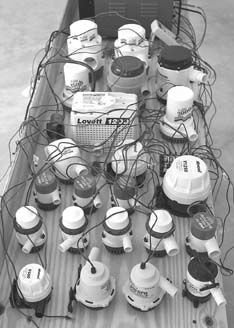
How We Tested
Following the procedures of our last bilge pump test, we measured flow rates and power ratings on all pumps at two voltages while pumping salt water into a tank set five feet above the pump.
ABYC (American Boat and Yacht Council) standards—currently being revised—say a bilge pump should be able to dry run at design voltage, that’s 13.6 volts for a 12-volt pump, for at least seven hours without failure. We added a test to confirm compliance with this standard. In the final analysis, we picked the top-rated pump in each group based on performance, warranty, wiring and price.
Testers began with the dry run. Because our 50-amp power supply was likely not capable of running all the pumps at the same time, we chose to run two shifts of 12 pumps each. After throwing in the three late-arriving pumps, we ended up running three shifts. All pumps passed the dry run test.
We mounted each pump to a test bench and added crimp-on ring connectors to the factory leads. We then connected them to a fuse panel with a fuse sized as close to specifications as we could find. Two feet of #14 wire connected our CSI Speco PSR-50 power supply to the pair of fuse blocks energizing the pumps. Monitoring supply voltage was accomplished with a Sperry DM-4100A digital multimeter. The actual dry run was accomplished in two steps. First, testers warmed up the pumps with two hours of running at 12.5 volts. Then we jacked the voltage up to 13.6 for the next seven hours. Total continuous dry running time on each pump was nine hours.
Flow testing was done as a two-step process on one pump at a time, both at 12.2 volts and 13.6 volts. Voltages and current draw were both measured at the power supply. We again used the Sperry multimeter to monitor supply voltage, plus we used a Fluke 336 clamp-on ammeter to record power usage. As each pump was run, it was timed and the pumped water quantity measured, allowing calculation of each pump’s flow rate.
Setup Details
Testers used two plastic tanks, one as a supply tank and the other as a receiver tank. The supply tank was a 200-gallon bait tank. We used a swimming pool pump to fill up the tank with water from the adjacent canal. Prior to each pump test, about 60 gallons of water was put into the supply tank. Each pump was attached to the same half-inch thick piece of plastic using its provided mountings. The plastic was then placed at the bottom of the supply tank and held in position with heavily weighted containers. For discharge hose, we used appropriately sized Unaflex Series 162 nylon reinforced plastic connected to the pump with a single clamp. It’s smooth bore PVC tubing and is recommended for use as bilge pump discharge hose. All hoses were 10 feet long. At the other end of the hose we single clamped a plastic bulkhead fitting, typical of one you’d find installed aboard most boats. This end of the hose was placed into the top of our receiver tank, a 22-gallon plastic tank marked in two-gallon increments. The receiver tank was located five feet above the level of the pump. Electricity was supplied to each pump from our power supply through 20 feet of #14 wire to the fuse panel and then on to the pump.
Wiring on each pump was rated in five areas. First, whether or not the wire is constructed of tinned copper, as is the consensus recommendation of marine electrical experts. We also stated the wire size, insulation temperature rating, insulation voltage rating, and—of most concern to an installer—the length of the leads. In our opinion, the leads simply can’t be too long. It’s best not to have any connections between the pump and the bus bar powering the pump. This lessens the chance that corrosion will attack the pump wiring. If the leads are too short to reach the bus bar you’ll be forced to add more wire with a butt connection or junction box, either of which gives corrosion another avenue into your wiring.
Pumps Under 400 GPH
Rule, Whale and Shurflo each have a single pump in this category. Prices range from $13 for the Rule 24 to $35 for the Whale SS3612. The Shurflo 380 is priced at the low-end: $16. All three pumps have 3/4″ outlets and all passed the dry-run test. All did well in performance testing, with the Whale shining brightest.
All are equipped with AWG 16 tinned copper wire; Rule and Shurflo have the highest-rated insulation, with a temperature and voltage rating well above the Whale. Lead lengths run from 25″ on the Whale, to 29″ on the Rule, to a whopping 69″ on the Shurflo. The Rule 24 is available with six-foot leads as the model 24-6, which adds about $2 to the price.
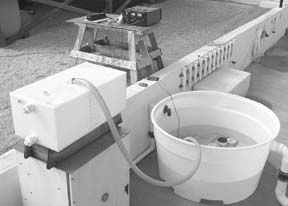
Both the Shurflo and Rule have vertically oriented motors and snap-on bases designed to mount on a horizontal surface. Each base also acts as the screen for the pump inlet. Shurflo has added features including a swivel base and a screw-in motor cartridge, the latter making debris removal easy. The Whale pump’s horizontally mounted motor gives it a lower profile and its base is designed for either vertical or horizontal mounting. Its motor can also be snapped out for easy debris removal.
Bottom Line: Our top pick in this group is the Shurflo Piranha 380. It edges the Whale with its longer warranty and lower price, and edged the Rule on performance. If you need a low-profile unit due to bilge space constraints, try the Whale. It’s the top performer, though pricy.
Pumps from 500 to 625 GPH
Every maker represented in our test, except Lovett, has a pump in this group. Six of the seven pumps range from $15 to $20. The Whale is much more expensive than the others: $44. All the pumps in this category possess 3/4″ outlets.
Performance varied widely in the group, even though five of the seven are marketed as 500 GPH pumps, one at 550, and the largest at 625.
Ironically, the worst performer was the pump with the highest advertised GPH rating—Attwood’s V625. It managed only 188 GPH at 12.2 volts and 251 GPH at 13.6 volts. Even the smaller Attwood V500 outperformed its big brother. We contacted Attwood to find out why the V625 seemed to perform so poorly. Attwood’s marketing director John Boot responded: “The performance you got out of our 625 pump is right on with what we state in our catalog and on the back of our aftermarket packaging. When we were doing marketing research on this product, some of our customers that manufacture boats with shorter sideboards wanted a pump with higher output than our 500. Our response was the 625, which provides greater output at lower head heights.” Attwood pump engineer Christopher Rossman explained the details: “As far as the performance of the V625 pump goes, it has been designed to be a low-head, low-amperage pump. [Your] performance numbers fall in line with the published numbers in our catalog. In a low-head situation you can get pretty good flow with a low current draw with this pump. This may be ideal for a lot of applications. Obviously this pump shouldn’t be used in a high- head application.”
The best-performing pumps in this bunch were the Whale and the Rule; both pumped at 75% of their marketed GPH or more on all tests. The Whale actually bested all others by hitting 99% of its rated GPH at 13.6 volts.
All wiring comments made in the under-400 GPH section on Rule, Shurflo and Whale pumps apply here as well. Attwood’s pair of pumps, the V500 and V625, both have leads 31″ long. Both pumps built by Johnson, the West and Mayfair, have 29″ leads. Insulation ratings are 600 volts and 105°C on all except the Whale.
Mounting, orientation and features listed for the under 400 GPH pumps by Rule, Shurflo, and Whale are identical in the larger 500 GPH pumps. Attwood and Mayfair pumps can be mounted on vertical or horizontal surfaces. The West Marine pump has three tabs extending from its base for mounting with screws to a horizontal surface.
Bottom Line: It’s a tight race in this group. We think the Rule edges the competition in the 500 to 625 GPH range based on good performance combined with a good price. This pump is also available with six-foot leads as the 25D-6. We’d gladly pay the extra $2.
Pumps from 700 to 1250 GPH
Attwood, Rule and Shurflo each have multiple pumps in this size range (three, two and two, respectively). Mayfair is also represented. Again, prices hold in a tight range, from $27 to $33. There is one exception: the Attwood V750 is the least expensive at $23. Outlet pipe sizes are split in this group, with four having 3/4″ and four 1-1/8″.
Performance was fairly close among pumps with the same outlet diameter but generally the pumps with the larger discharge pipe pushed more water. The standout was the Shurflo 1000, which was able to pump 85% of its rating at 12.2 volts and 93% at 13.6.
Wiring, mounting, orientation, and features mentioned in the previous sections also apply to these pumps.
Bottom Line: Shurflo wins its second division with its Piranha 1000. Performance, warranty, wiring, and price are a powerful combination.
Pumps over 1400 GPH
These are the big boys, in size, price, power consumption, and water flow. Rule outnumbers all others here with four pumps, Attwood has a pair, and the Johnson-built West Marine brings the total to seven. The least expensive pump in the group is the Attwood HD1700 at $53. Next is the Rule Model 2 at $60, then the Attwood HD2000 at $66, the West Marine 491720 at $70, and the Rule 10 at $80. At nearly double these prices are the Rule 14A and Rule 56D, both at $155. All pumps except the two giant Rule pumps have 1-1/8″ outlets. The Rule 3700 has a 1-1/2″ outlet, and the Rule 4000 a 2″. Acceptable performance was obtained from all units tested, though these large pumps have a more difficult time than their smaller brethren maintaining their GPH rating at high lift and low voltage.
All the pumps in this group are equipped with wire insulation rated at 600 volts and 105°C. Wire on the two big Rule pumps is a size larger than the others and all except the West have leads less than 36” length. The West has 71″ leads. Three of the Rule pumps are available with 6-foot leads, Model 2 as the 02-6, Model 10 as the 10-6UL, and the 14A as the 14A-6UL.
Motors on all pumps are vertically oriented, and the base of each is designed to be fastened to a horizontal surface and double as the pump screen.
Bottom Line: Our top choice in the large pump division is the West Marine 491720. It’s less expensive than pumps with comparable performance, has a three-year warranty, and comes standard with long leads.
Float-Switch Pumps
Only two of the pumps we tested fit into this group. Lovett and Attwood each have a single pump containing an internal float switch. Though different in most respects, they have at least two similarities. They both have 1-1/8″ outlets, and they performed the same. The differences begin with pricing; at $130 the Lovett 1200 is $40 more expensive than the Attwood Sahara 1100, which sells for $90.
Size and construction are also quite different. The Lovett is by far the largest pump of its capacity we tested. It has a rectangular shape and measures 5″ by 8″ by 6″ high. Other notable Lovett features include tough high-quality construction, rebuildable design, sheath cover wiring, monel shaft, and an airlock design with no seals to wear out. We feel owners of the Lovett got shorted on two fronts” The cable lead is too short at 26″, as is the warranty at one year. The short cable can be overcome by the rebuildable nature of this pump. If it proved necessary, you could disassemble the pump and replace the wiring—increasing its length as needed.
Attwood’s Sahara is about one-third the size of the Lovett, not nearly as heavily constructed, and carries a three-year warranty.
Bottom Line: If you’ve got the room and insist on having a built-in float switch, we think the Lovett is a good pump. On January 1, 2004, Lovett will increase the warranty period on its pumps to three years.
Conclusions
Things have changed since our last bilge pump test. At that time nearly all the pumps tested had one-year warranties and short wire leads. This time nearly all the pumps tested have three-year warranties, with more to come. In addition, several come equipped with leads over five feet long. Another bunch from Rule can be ordered with six-foot leads. These are major improvements for the marine consumer. We considered both of these factors equally with performance and price to determine winners.
Rather than extrapolate performance numbers for various lifts, we stuck with the GPH rating each pump uses for marketing—normally its zero lift or open bucket rating—and based all of our performance numbers on a percentage of the marketed GPH rating.
When marine consumers search for a replacement pump, they’ll be looking first for the correct size in GPH, not the GPH rating for 1 or 2 meters of lift, which they may or may not find on the package. This is why we grouped the pumps in size ranges suitable to most boats. We know that some overlap may exist between categories.
All of our top picks scored highly in these areas: performance, price, wiring and warranty.
In the small pump group, rated at less then 400 GPH, we selected the Shurflo Piranha 380. In the 500 to 625 GPH range, the Rule 25D was our top choice. In the 700 to 1250 GPH range, the Shurflo Piranha 1000 was top dog. And in the over-1400 GPH pumps, we selected the West Marine 491720.
In the last category, pumps with an internal switch, we selected the Lovett 1200 as our top pick. The Lovett warranty extension from one to three years firms up this pump’s top position.
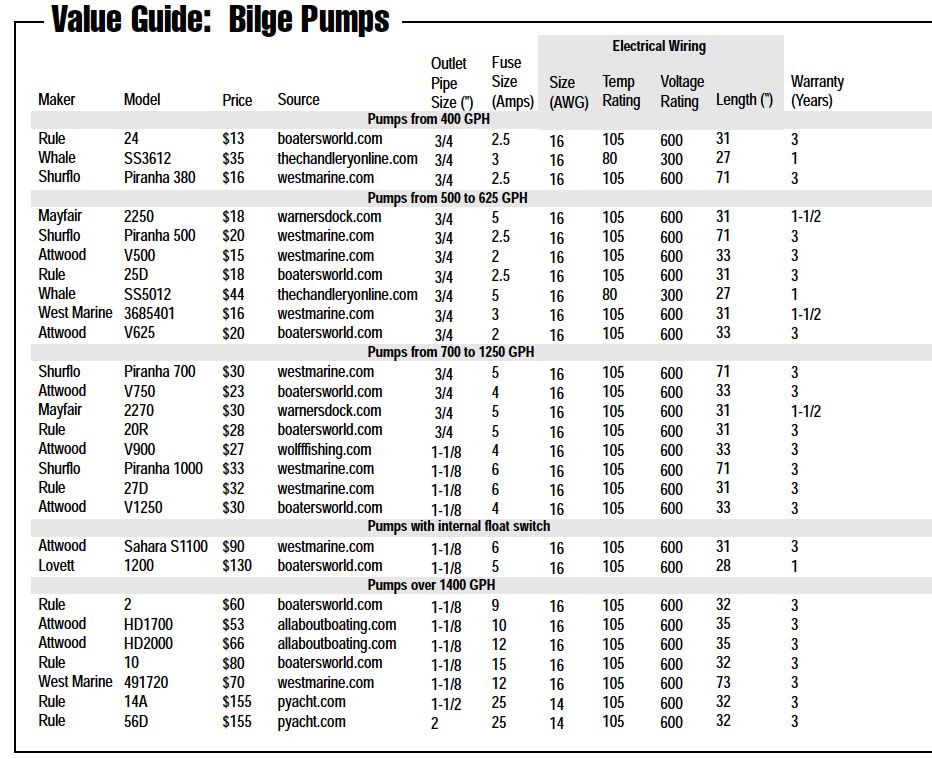
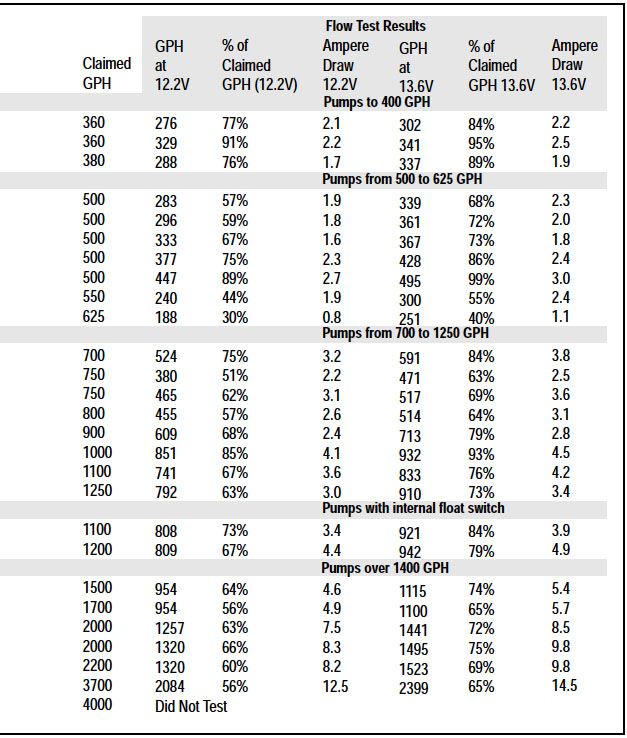
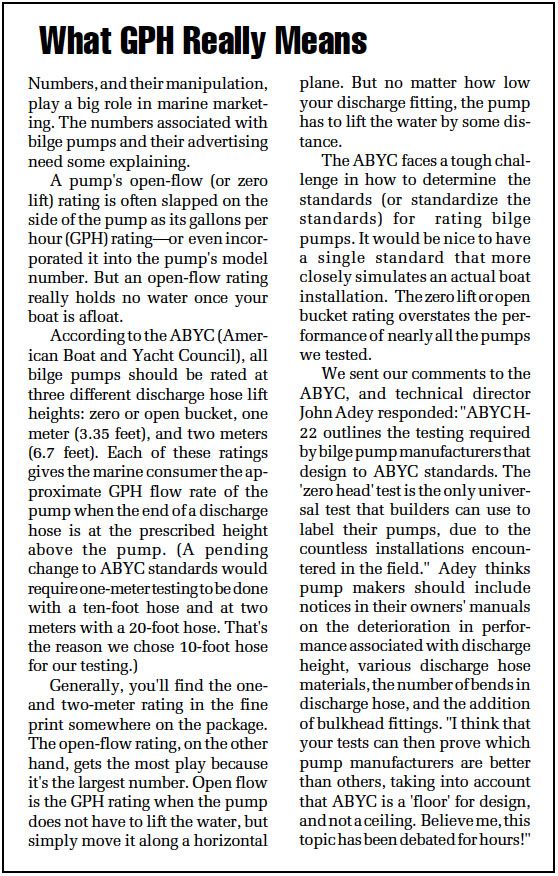
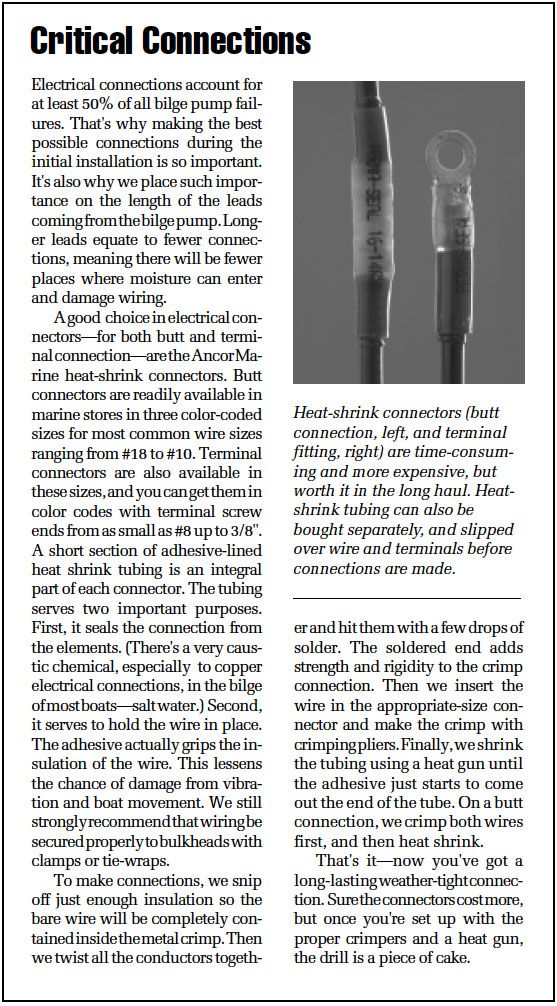
• Attwood, 616/897-9241, www.attwoodmarine.com
• Lovett Marine, 800/673-5976, www.lovettmarine.com
• Johnson Pumps (West Marine, Mayfair), 847/671-7867, www.johnson-pump.com
• ITT Industries (Rule), 978/281-0440, www.rule-industries.com
• Wicor (Shurflo), 562/795-7709, www.shurflo.com
• Munster Simms (Whale), 978/531-0021, www.whalepumps.com
• West Marine, 800/262-8464, www.westmarine.com





























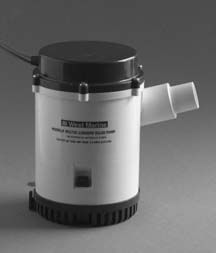




Thanks…
Thanks for useful article!
Toilet waste is a pain to deal with for many boaters. These pumps offered an effective solution.
Again thanks!